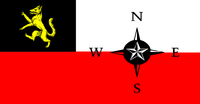Atlanta

| |
| Population: | 423,000 (approx 2.9 million in Greater Metropolitan Area |
Atlanta is the largest city and capital of the NAL province of Jacobia. Sometimes called the "Capital of the American South" or "The Big Peach" (an echo of New Amsterdam's "The Big Orange"). Today the fast-growing city remains a transportation hub, not just for the country but also for the world: Hartsfield Atlanta International Aerodrome is one of the nation's busiest in daily passenger flights. Direct flights to Europe, South America, and Asia have made metro Atlanta easily accessible to the more than 1,000 international businesses that operate here and the more than 50 countries that have representation in the city through consulates, trade offices, and chambers of commerce. The city has emerged as a banking center and is the world headquarters for 13 Fortune 500 companies.
Some places and details of interest:
- Stone Mountain – suburb just east of the city where the CBI has its training academy.
- MARTA (Metropolitan Atlanta Rapid Transit Authority) is one of the most modern in the nation.
- Underground Atlanta, which is literally an area of downtown that was built over. The result was and is about three city blocks-worth of storefronts below Atlanta's city streets.
- Jacobia University, a lavishly endowed institute of higher learning.
- Over one hundred streets, boulevards, avenues, lanes, circles, courts, places, ways, squares and paths in variations north, south, east, west, new, old, little, small, long, short, etc. all with the name Peachtree.
- Decatur with 18,000 inhabitants is the most well-known “gay” neighborhood perhaps in the NAL.
- Several large corporations have their HQs in Atlanta, including the National News Company (NNC) and Thorne House (a major publishing firm).
- Five Points is halfway between a neighborhood and suburb of Atlanta, and since the 1920s has had a growing population of refugee/immigrant from the RTC following the tumult of the First Great War and then the Second Great War. It is one of the largest concentrations of followers of the Romuva religion in the Americas.
- St. George's Cathedral is one of the oldest buildings in the city, a simple but beautiful (some say disturbing) design deliberately echoing English architect Nicholas Hawksmoor (1661-1736).
Location
Atlanta is located in the northwest area of Jacobia, at a hub of several different railway lines as well as the location of one of the largest international aerodomes in the world. At the same time, it is a very verdant area, so that technically the entire city is legally considered a forest.
Administration
Atlanta has a Mayor who is chosen in a general election every five years. Working with the Mayor is a nine-member Board of Aldermen, elected from different districts within the city for six year terms. Every three years, one third of this Board is up for re-election. The Board elects a Chair from its members, who shares with the Mayor executive authority in the city. Their specific areas of responsibility are spelled out in the City Charter.
The charter originally had a five-member Board electing the Mayor until 1990 when a referendum raised the number of Aldermen from five to nine and provided for direct election of the Mayor.
Politically, the city gives a much stronger voice to smaller national parties such as the Democratic Socialists, the National Capitalists and even (for a time) the Unionists. Many Aldermen have been nominated by more than one of city's political parties.
History
It is important to understand that the city of Atlanta was born soon after the end of slavery in the NAL. This fact shaped the city fundamentally because it offered an opportunity for freed slaves and difers to start over, make new homes for themselves, build new lives.
Atlanta was founded in 1837 as the end of the Western & Atlantic railroad line (it was first named Marthasville in honor of the then-governor's daughter, nicknamed Terminus for its rail location, and then changed soon after to Atlanta, the feminine of Atlantic -- as in the railroad).
By 1870, Atlanta was home to over 20,000 people. Many of those lost their homes in the Great Fire of 1875, believed to have been the result of arson during riots of that year. Yet the city did rebuild, mostly under the leadership of Frederick Bailey, the city's first Afroe Mayor.
During the XXth century, a kind of rivalry between Atlanta--the largest city in Jacobia--and Savannah--the oldest--developed. The latter was increasingly looked upon as a bastion of the old Bourbons (Southern aristocratic families) while Atlanta epitomized the "Nouveau South," to the point where some sneeringly refer to it as Difertown.
Between 1977 and 1979 Atlanta suffered its worst trauma. The bodies of twelve Lithuanian children, aged between nine and thirteen, were found in and around the Five Points area of Atlanta. Eventually, the Five Points Killer proved to be an alcholic young ex-con named Geoffrey Dahlstrom, but he was caught only after one of the most divisive police investigations in the city's history. Local police were initially deceived by a series of letters purporting to be from the killer and dismissed CBI conclusions that they were from someone else (this was the first high-publicity use of "Offender Analysis"). The letters, it turned out, were from a disgruntled detective who loathed the officer heading the investigation. Yet it was a local police detective who organized the successful manhunt focussing on the ART system (the predecessor of MARTA). Dahlstrom was convicted in 1980 and killed in prison six years later.
The last decade has seen the Alliance for Public Decency become an increasingly powerful force in city politics, after setting up its national offices in Atlanta. This has sparked (or inflamed) tensions with the Romuva minority who are not Christians, as well as the large LGBT community in the city.


